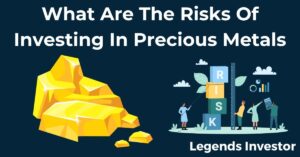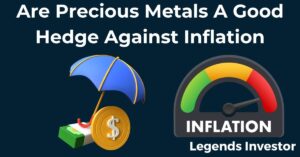Unveiling the Luster: An Introduction to Precious Metals
Precious metals have captivated human interest for centuries, standing as symbols of wealth, power, and beauty. From ancient civilizations to modern economies, these metals have played an integral role in shaping history and finance. In this comprehensive guide, we’ll explore the definition, types, economic impact, and various applications of precious metals, offering insights into why they remain so valuable and relevant today.
Definition of Precious Metals and Their Distinguishing Characteristics
What Are Precious Metals?
Precious metals are rare, naturally occurring metallic elements with high economic value. They are characterized by their rarity, durability, and intrinsic beauty. Unlike base metals, which are more common and less valuable, precious metals are prized for their scarcity and unique properties.
Distinguishing Characteristics
- Rarity: Precious metals are found in limited quantities in the Earth’s crust, making them valuable.
- Durability: They are resistant to corrosion and tarnish, which contributes to their longevity.
- Malleability: Many precious metals can be easily shaped and worked into various forms.
- Aesthetic Appeal: Their natural luster and color make them highly desirable for decorative purposes.
Historical Context and the Role of Precious Metals in Human Civilizations
Ancient Civilizations
Throughout history, precious metals have been symbols of power and wealth. In ancient Egypt, gold was considered the flesh of the gods, and pharaohs adorned themselves with golden jewelry and artifacts. The Romans used silver and gold coins as currency, which facilitated trade and economic development.
Medieval and Renaissance Eras
During the medieval period, precious metals were used to craft religious artifacts and royal regalia. The Renaissance saw a resurgence in the use of gold and silver for art and coinage, reflecting their continued importance in society.
Modern Economies
In contemporary times, precious metals maintain their status as valuable assets. They are used in various industries, including technology and finance, and continue to be a store of value and a symbol of economic stability.
Why Precious Metals Remain Valuable in Modern Economies
Store of Value
Precious metals are often seen as a hedge against inflation and economic instability. Unlike fiat currencies, which can lose value over time, precious metals have intrinsic value and can retain purchasing power during economic downturns.
Financial Diversification
Investors use precious metals to diversify their portfolios. They serve as a safe haven during periods of market volatility, providing stability and protection against financial risks.
Industrial Demand
In addition to their financial value, precious metals have significant industrial applications. Their unique properties make them essential in various technologies and manufacturing processes.
The Elite Circle: Types and Examples of Precious Metals
Gold’s Timeless Allure: Usage and Significance
Gold is perhaps the most well-known precious metal, celebrated for its beauty and value. It has been used for jewelry, coins, and art for thousands of years. In modern times, gold remains a popular investment asset and is widely used in electronics and medical devices due to its conductivity and biocompatibility.
Silver’s Dual Role: Industrial Demand and Precious Status
Silver, often called the “poor man’s gold,” has both industrial and monetary significance. It is used in a wide range of applications, from electronics to solar panels, and is also valued for its use in coins and jewelry.
Platinum Group Metals: Rarity Meets Utility
Platinum group metals (PGMs) include platinum, palladium, rhodium, ruthenium, iridium, and osmium. These metals are known for their rarity and diverse applications, including catalytic converters in automobiles and various industrial processes.
Other Notable Precious Metals: Palladium, Rhodium, and Beyond
- Palladium: Known for its use in catalytic converters and electronics, palladium has gained prominence as an investment asset.
- Rhodium: Highly valuable and used primarily in automotive catalytic converters, rhodium is known for its high reflectivity and corrosion resistance.
- Osmium and Iridium: These metals are used in specialized applications, including electrical contacts and fountain pen tips.
The Economic Impact of Precious Metals
How Precious Metals Influence Global Finance and Economies
Precious metals play a crucial role in global finance. They are used as reserves by central banks, and their prices can influence market sentiment and economic stability. Fluctuations in precious metal prices can impact inflation, interest rates, and investment strategies.
Precious Metals as a Hedge Against Inflation
Precious metals, particularly gold and silver, are often used as a hedge against inflation. When inflation erodes the value of currency, precious metals typically retain their purchasing power, providing a safeguard for investors.
The Role of Precious Metals in Currency Valuation
Historically, many currencies were backed by precious metals, such as the gold standard. While this practice is no longer common, the value of precious metals can still impact currency valuation and economic policies.
From Earth to Market: The Mining and Refinement of Precious Metals
Overview of the Mining Process for Precious Metals
Mining precious metals involves several stages, including exploration, extraction, and processing. Techniques vary depending on the metal and the location but generally include underground mining, open-pit mining, and placer mining.
Challenges and Environmental Impact of Extraction
Precious metal mining can have significant environmental impacts, including habitat destruction, water contamination, and soil erosion. Efforts are being made to mitigate these effects through sustainable practices and reclamation efforts.
Refining Techniques and Ensuring Purity
Refining is the process of purifying extracted metals to achieve desired levels of purity. Techniques include smelting, electrolysis, and chemical treatments. High purity is essential for ensuring the quality and value of precious metal products.
Precious Metals in Technology and Industry
Technological Applications of Gold and Silver
- Gold: Used in electronics for its excellent conductivity and resistance to corrosion. It is also employed in medical devices and aerospace technologies.
- Silver: Utilized in solar panels, batteries, and electronic components due to its high conductivity and antimicrobial properties.
Industrial Uses of Platinum and Palladium
- Platinum: Used in catalytic converters to reduce vehicle emissions, and in various industrial applications such as chemical processing and electronics.
- Palladium: Also used in catalytic converters, as well as in jewelry and electronics due to its resistance to corrosion and excellent catalytic properties.
Future Trends: Precious Metals in Green Technology
Precious metals are increasingly being used in green technologies, such as hydrogen fuel cells and electric vehicles. Their unique properties make them essential for developing sustainable and efficient energy solutions.
Precious Metals as Investment Vehicles
Understanding Bullion, Coins, and Bars
- Bullion: Precious metals in bulk form, typically traded based on weight and purity. Common forms include gold and silver bars.
- Coins: Legal tender with intrinsic value, often used for investment and collection purposes. Examples include gold and silver bullion coins.
- Bars: Generally available in various weights and are a popular form of investment.
ETFs, Stocks, and Mutual Funds Linked to Precious Metals
- ETFs (Exchange-Traded Funds): Track the price of precious metals and allow investors to gain exposure without physically owning the metals.
- Stocks: Shares of companies involved in mining or refining precious metals. Investing in these stocks provides indirect exposure to precious metal markets.
- Mutual Funds: Offer diversified exposure to precious metals through a portfolio of assets related to the industry.
The Risks and Benefits of Investing in Precious Metals
Investing in precious metals offers benefits such as diversification, inflation protection, and potential appreciation. However, it also carries risks, including price volatility, storage costs, and market liquidity issues.
The Artistry of Precious Metals: Jewelry and Decorative Uses
Precious Metals in Jewelry Making: A Blend of Beauty and Tradition
Precious metals like gold, silver, and platinum are widely used in jewelry making. Their durability and aesthetic appeal make them ideal for creating beautiful and long-lasting pieces.
Notable Art and Decorative Objects Made from Precious Metals
Throughout history, precious metals have been used to craft stunning art and decorative objects, including religious artifacts, royal regalia, and intricate sculptures.
Caring for and Valuing Precious Metal Items
Proper care is essential for maintaining the value and appearance of precious metal items. Regular cleaning, proper storage, and professional maintenance can help preserve their beauty and worth.
Legal and Ethical Considerations in the Precious Metals Trade
Regulation of Precious Metal Trading
Precious metal trading is subject to various regulations to ensure market integrity and protect investors. These regulations cover trading practices, transparency, and reporting requirements.
Ethical Sourcing and the Fight Against Conflict Metals
Efforts are being made to address ethical concerns related to the sourcing of precious metals, particularly those associated with conflict and human rights abuses. The industry is working towards greater transparency and responsible sourcing practices.
Certifications and Standards for Ethical Precious Metals
Certifications such as the Responsible Jewellery Council (RJC) and Fairmined help ensure that precious metals are sourced ethically and sustainably. These standards promote responsible practices throughout the supply chain.
Navigating the Future: Precious Metals in a Changing World
Impact of Technological Advancements on Demand for Precious Metals
Technological advancements are shaping the future demand for precious metals. Innovations in electronics, green technology, and medical applications are driving new uses and increasing the need for these metals.
Challenges Posed by Counterfeit Metals and Market Fraud
Counterfeit precious metals and market fraud pose significant challenges. To combat these issues, the industry is implementing advanced verification techniques and promoting transparency.
How Recycling and Sustainability Are Shaping the Future of Precious Metals
Recycling and sustainability are becoming increasingly important in the precious metals industry. Efforts to recycle precious metals from electronic waste and other sources help reduce environmental impact and ensure a steady supply.
Conclusion
Precious metals continue to play a vital role in our world, from their historical significance to their modern applications



